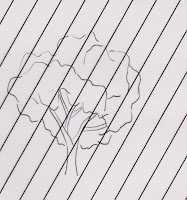Highlights - where the light first hits your image. We show a highlighted area by absence of color or a lighter color. Highlights are normally shown by using Copic colors ending with numbers like OOOO, OOO, up to markers ending in 03.
Shading - Where the light hits less than than another place on the image, but not the darkest. AKA mid-tones. This is your main color normally a Copic color number about 2 numbers brighter than your highlight color or numbers ending in no higher than a 5-6.
Shadows - Where the light hits least or not at all. This is normally shown by using a grayer or darker color.
Cast Shadow -A cast shadow is formed due to light not being able to pass through an object. The cast shadow simulates the image or object that is blocking the light. A cast shadow is not always gray, but a muted or darker color of the image it is revealing itself on. IE: The tree is casting a shadow on grass that was colored with YG03, I colored the shadow with a YG63 which is a grayer shade of YG03. I could have reached a similar outcome by shading with a N3.
 age.
age.
Let's start by doing a light study prior to starting to color our image. This is done with a Lighting Guide Template which can be made on a transparency with lines drawn on it. The lines represent the light. As light travels in straight lines.
 one round image but several clumps of greenery. Each section is treated separately and as related to the others (ie: behind, in front of etc).
one round image but several clumps of greenery. Each section is treated separately and as related to the others (ie: behind, in front of etc).
Took your class today in Tucson, AZ. Absolutely LOVED your techniques! Thank you so much!
ReplyDeleteThanks so much for posting this. Wish one of these classes would come to my area (Northern California.) Love your blog Jennie! I'm a new follower and will be attending your class on Sunday up in Sacramento, CA. :-)
ReplyDelete